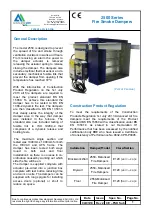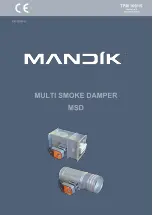
36
TPM 109/15
11. Logistic terms
11.1.
Dampers are transported by box freight vehicles without direct weather impact, there must not
occur any sharp shocks and ambient temperature must not 40 °C. Dampers must be
protected against mechanic damages when transported and manipulated. During transportation,
the damper blade must be in the "CLOSED" position.
VI. TRANSPORTATION AND STORAGE
11.2.
Dampers are stored indoor in environment without any aggressive vapours, gases or dust. Indoor
temperature must be in the range from -5 °C to +40 °C and maximum relative humidity 80 %.
Dampers must be protected against mechanic damages when transported and manipulated.
12.1.
Assembly, maintenance and damper check can be done only by qualified persons, i.e.
"AUTHORIZED PERSONS" that have been trained by the manufacturer.
Trainings are done by the firm MANDÍK that makes out a proficiency "CERTIFICATE" which is
valid for 5 years. It can be renewed by the "AUTHORIZED PERSONS" themselves, directly at the
manufacturer.
When the "CERTIFICATE" expires, it becomes invalid and is eliminated from the trainer´s
registration.
Only professional personnel that undertake guarantee for the completed work can be trained.
VII. ASSEMBLY, ATTENDANCE, MAINTENANCE AND REVISIONS
12. Assembly
12.2.
All effective safety standards and directives must be observed during fire damper assembly.
12.3.
Flange and screw joints must be conductively connected to protect against dangerous contact. 2
galvanized fan shape pads that are placed under the head of one screw and a fastened nut are
used for conductive connection.
12.4.
To ensure reliable fire damper function it is necessary to avoid blocking the closing mechanism
and contact surfaces with collected dust, fibre and sticky materials and solvents.
12.5.
Manual operation
Without power supply, the damper can be operated manually and fixed in any required
position. Release of the locking mechanism can be achieved manually or automatically
by applying the supply voltage (design 4Mx or 5Mx).
13. Entry into service and revisions
13.1.
Before entering the dampers into operation after assembly and after sequential revisions, checks
and functionality tests of all designs including operation of the electrical components must be
done. After entering into operation, these revisions must be done according to requirement set
by national regulations.
In case that dampers are found unable to serve for their function for any cause, it must be clearly
marked. The operator is obliged to ensure so that the damper is put into condition in which it is
able to function and meanwhile he is obliged to provide the fire protection another appropriate
way.
Results of regular checks, imperfections found and all-important facts connected with the damper
function must be recorded in the "FIRE BOOK" and immediately reported to the operator.
Содержание MSD Square
Страница 1: ......





















